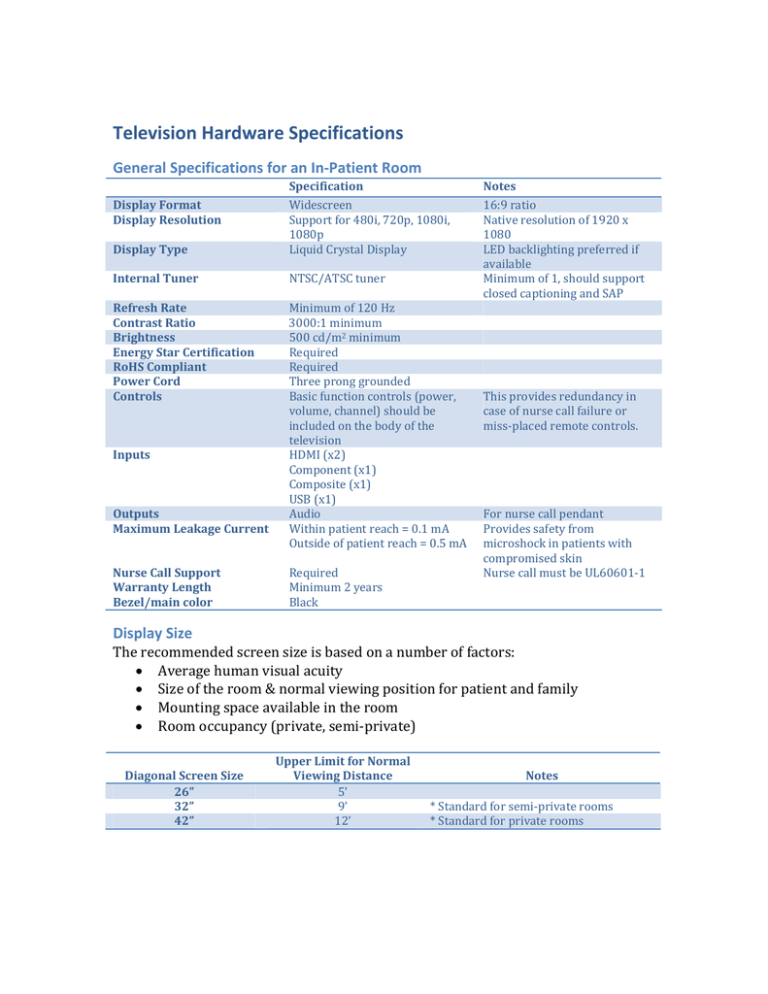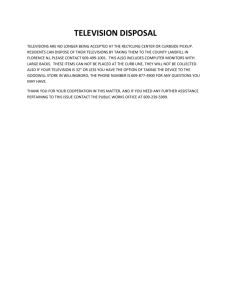Television Hardware Specifications
advertisement

Television Hardware Specifications General Specifications for an In‐Patient Room Specification Notes Display Format Display Resolution Display Type Widescreen Support for 480i, 720p, 1080i, 1080p Liquid Crystal Display Internal Tuner NTSC/ATSC tuner Refresh Rate Contrast Ratio Brightness Energy Star Certification RoHS Compliant Power Cord Controls Minimum of 120 Hz 3000:1 minimum 500 cd/m2 minimum Required Required Three prong grounded Basic function controls (power, volume, channel) should be included on the body of the television HDMI (x2) Component (x1) Composite (x1) USB (x1) Audio Within patient reach = 0.1 mA Outside of patient reach = 0.5 mA 16:9 ratio Native resolution of 1920 x 1080 LED backlighting preferred if available Minimum of 1, should support closed captioning and SAP This provides redundancy in case of nurse call failure or miss‐placed remote controls. Inputs Outputs Maximum Leakage Current Nurse Call Support Warranty Length Bezel/main color Required Minimum 2 years Black For nurse call pendant Provides safety from microshock in patients with compromised skin Nurse call must be UL60601‐1 Display Size The recommended screen size is based on a number of factors: • Average human visual acuity • Size of the room & normal viewing position for patient and family • Mounting space available in the room • Room occupancy (private, semi‐private) Diagonal Screen Size 26” 32” 42” Upper Limit for Normal Viewing Distance 5’ 9’ 12’ Notes * Standard for semi‐private rooms * Standard for private rooms Hospital Grade The Underwriters Laboratories (UL) provides a standard certification for the safety of consumer television hardware from risk of fire, burn, and electrical shock, etc. The UL provides additional requirements and restrictions on devices intended to operate in challenging or high risk environments such as outdoor/wet locations, in‐ wall or under‐cabinet mounting, connecting TVs to a network, and healthcare facilities. There are some differences in the qualifications of consumer and hospital grade devices, most of which are intended to enhance safety in a hospital setting when the TV has components that will be in the vicinity of the patient or in the patient’s bed. UL does not formally designate requirements for ‘commercial grade’, though many manufacturers produce products in this class. Commercial grade may imply a different set of available connectors, improved durability or reliability, and/or more or fewer core features (for example, some commercial displays do not include a tuner). Certification Area Consumer Grade Hospital Grade UL6500 UL6500.H Maximum Operating Temperature Section 7.1.5 Maximum AC Leakage Current Section 9.1.1 Enclosure Openings Section 9.1.8 Maximum Impact Resistance Section 12.1.3 Signaling and Nurse Call Controls Section 1.1.1 Transformer Construction & Grounding Section 14.3.4 Power Switch Section 14.6.1.1 Hospital Grade AC Plug Section 15.1.1 Power Cord with Grounding Wire Section 15.1.1 Minimum Wheel & Caster Size Section 10.8 60°C (140°F) 500 μA 750 μA mounted devices 25°C (77°F) “on an appendage that will be taken into a patient’s bed” 100 μA touched by patients 500 μA mounted out of range 4 mm enclosure openings No openings permitted on non‐ on any surface vertical surfaces (reduces risk of fluid entry) 3.5 J 7 J N/A Must support UL1069 products when feature is provided Consumer construction and safety requirements Must meet UL60601‐1 hospital safety requirements Single Pole Allowed All Pole Required N/A Required N/A Third wire grounding conductor required N/A 10 cm (3.93 in) Healthcare facilities are required by CMS to insure a safe environment for employees, patients, and visitors. The hospital is not specifically required to use UL hospital grade equipment, but should evaluate where they may be appropriate. Note that it may be possible for a device to meet the specific requirements in this standard without achieving (or pursuing) UL Hospital Grade Listing. It may also be possible that a hospital grade TV does not meet the standards set forth in this document (for example, a hospital grade TV is allowed to lack a nurse call connection). A decision tree will be utilized to provide guidance on the selection of TV type due to safety concerns (see below). Note that the guidance provided by this tree may be modified by requirements outside of safety concerns. For example, a wall‐mounted TV in a low‐acuity patient room does not demand hospital grade certification for safety reasons, however, it is likely that a hospital grade TV will be deployed due to the need for nurse call integration (a feature that is uncommon in consumer TVs). *START* YES Will TV be used in a ‘wet’ area? NO YES Will be used around patients with compromised skin? Device regularly touched or subject to direct spill? YES UL6500.H Hospital Grade Safer solution due to: •Less leakage current allowed •Limited fluid entry points •UL listed power supply NO NO Heavy duty‐cycle expected? Hard to swap? High Availability Required? More robust solution due to: YES •Designed for longer life Consider •Additional connectors Commercial Grade •USB cloning NO UL6500 Consumer Grade Preferred Standard Solution due to: •Cost effectiveness •Feature availability Mechanical, Electrical, Plumbing, and Network Considerations Mechanical Backing capable of supporting 75 lbs shall be provided from a height of five (5) feet from the floor to the ceiling in areas planning to use wall‐mounted televisions. Televisions will be mounted such that the bottom bezel is five (5) feet from the floor. Televisions will be mounted flush to the wall where possible to avoid collision risk. Electrical One duplex outlet (non‐emergency power) shall be installed at an elevated height six (6) feet or higher such that the television may plug in directly behind the display and hide the cord from site. Plumbing Televisions shall not be mounted in such a way as to compromise existing active sprinkler systems. Televisions shall not be mounted within four (4) feet of a sink to avoid the possibility of damage from inadvertent splash. RF Cabling A single, quad‐shielded coaxial RF outlet (antenna) will be located adjacent to the duplex electrical outlet behind each television site. Network At least one cat6 network outlet will be located adjacent to the RF coaxial connection behind the television.



